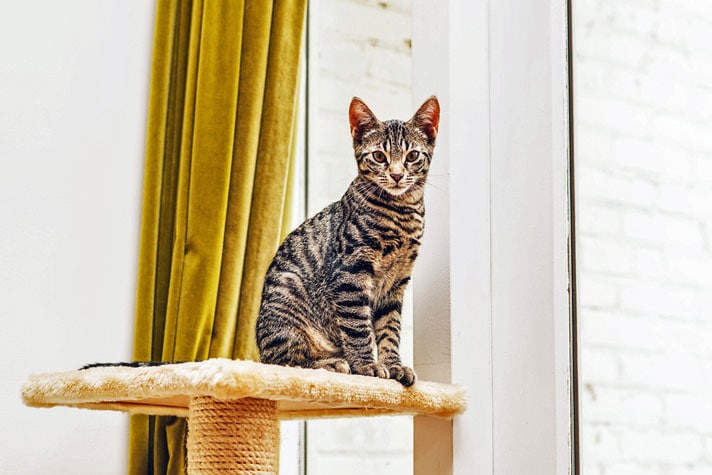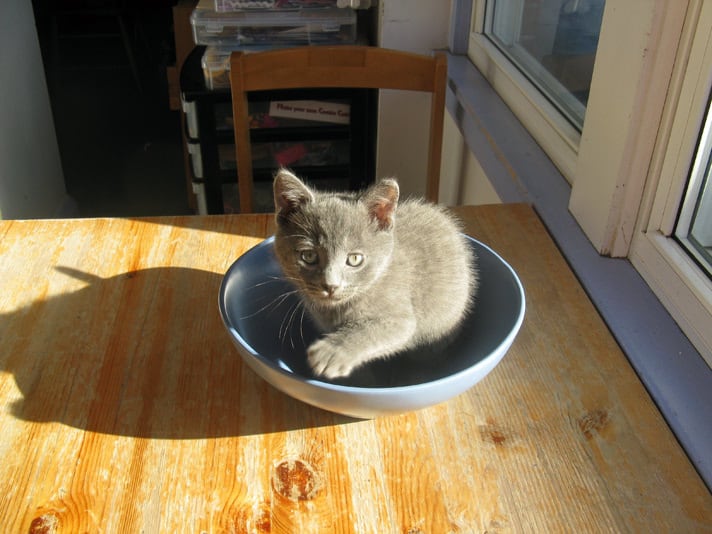Oh, the curiosity of kittens! These furry, miniature explorers have an insatiable desire to learn about their world. And, depending on how old they are, they also have the athleticism to jump and pull themselves up onto counters, curtains, tables — you name it! While they’re having fun investigating, you want to be sure you reward good behaviors and avoid inadvertently giving attention to, and thus reinforcing, behavior you don’t want. Making a clear plan and getting the whole family on board will avoid future problems.
All creatures, but especially the young, quickly learn from the consequences of their actions. When doing something results in an outcome they like, they do it again. When an action doesn’t get them what they want, or it results in something less pleasant, they tend not to repeat it. Remembering this simple equation, you can create safe “lessons” for your kitten to develop good habits.
To keep your kitten off counters, tables and other pieces of furniture, you’ll want to provide appropriate, “legal” opportunities for jumping and climbing as well as avoid that unintentional reinforcing of unwanted behaviors.
Creating A Kitten Climbing Zone
Kittens do need places they can climb, hide and play without you having to worry about damage. Those crazy structures covered with carpeting — usually called cat trees — are really good investments because they’ll take the abuse instead of your couch.
If you can’t afford the investment, you might be able to make something similar with strong boxes taped together with holes cut out for exploring. If possible, make it tall and/or secure it in a place that gives the kitten a view of the room from 3 feet or higher.

A cat tree provides your kitten with an appropriate place to climb and from which to survey the room. Ysbrand Cosijn/iStock/Thinkstock
In general, cats like the height of safe perches in the corners of rooms. Here are some other tips on creating a cat tree your kitten can’t resist:
Place the cat tree in a room you spend time in, near a seat you will use often. While these kinds of perches are not always in keeping with the general décor of a room, putting it off in a remote spot away from you will reduce its value to your kitten.
To help make little Fuzzy love that cat tree, rub it with some fresh or dried catnip leaves. Place a few yummy treats in the nooks and crannies of the structure to reward kitty for exploring it. If she shows any fear or concern about this new thing in her space, give her a day or so to acclimate to it.
Make it come alive! Drag a string or wand toy up and around it to entice play and exploration. Kittens can hardly resist moving targets. Don’t just drop a toy on it — make the toy move!
Allow kitty to scratch it, sleep on it, hide from you, etc. Try not to interrupt her when she’s on it. Let it be a safe place for her.
Discouraging Kitten Climbing
If your kitten jumps up on places and surfaces you don’t want her, be prepared to gently move her repeatedly — maybe 15 to 25 times, often several in a row.
If possible, don’t scold or startle her, just make moving her a consequence of her jumping up on the undesired spot. Scolding might make her scared of you, but cuddling her while you move her might inadvertently reward her with attention. Just walk toward her, not even looking at her, gently pick her up, and put her either in her play area or on the floor. Don’t make a big deal — just help her learn that jumping up there will not result in her being able to stay. Repetition is the key to success here, so be as consistent as you can about the removal.

Spider cat, spider cat. Does whatever a spider cat does. Via Clevergrrl/Flickr
When you can, take a moment to determine why she wanted to be there. Is it soft? Is it near food? Is it near you? Is it away from another cat or dog, or a child? Is she looking to play, or just bored? If you can identify her motivation and fulfill her desire in another place, preferably the climbing/playing area you created for her, why would she continue?
If there is something attractive about the spot you don’t want her to jump up on, and you cannot change that — like, when you are preparing food on the kitchen counters — work on changing the situation in a way that works for all of you. That might mean having another family member play with her or feed her small treats away from the kitchen, or it might mean restricting her to another room while you cook. Think of ways you can avoid the problem, like having a play session and then feeding her dinner before you prepare yours. Make sure you don’t leave attractive items on the counter or dining table. Taking extra care while she’s a kitten will avoid a repetitive issue, and will keep her from starting habits you don’t want.
Anytime you are seeing behavior you don’t want, try to casually interrupt and make the case for doing something else instead. Contrary to common belief, cats are trainable! Unless she’s going to do damage, gentle redirection is best. If you give too big a response or engage your kitten with lots of petting or attention, you could actually be encouraging her to do it again.
By: Janet Velenovsky
Share:









